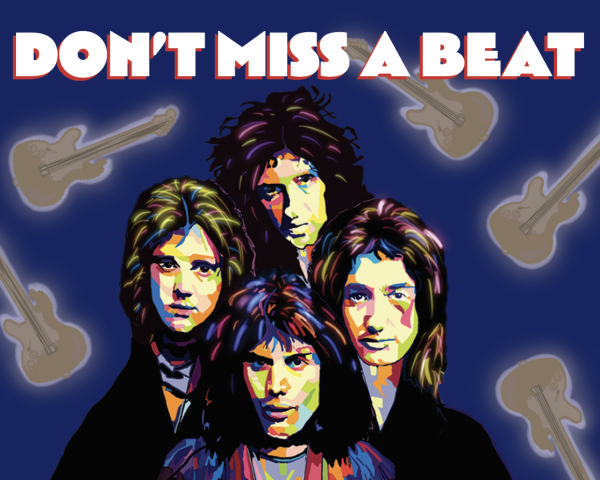Exhibit: The Art of Disability Culture
The stories behind the artists at the Palo Alto Art Center’s latest exhibition

One in four Americans live with a disability at some point in their lives, according to the CDC. However, all disabilities, whether visible or invisible, lack accurate, authentic representation in society.
To showcase inclusion, accessibility and interdependence, the Palo Alto Art Center welcomes the exhibit “The Art of Disability Culture: Artists with Disabilities Dispelling Myths, Dissolving Barriers, and Disrupting Prejudice” from Sept. 11 to Dec. 11, 2021.
Each artist featured in the exhibit lives with one or more disabilities. Through their unique artwork, they spark conversation, evoke self-reflection and reclaim the disability narrative.
[Image Description: A white woman with short red hair stands to the right of her painting, They is Loved: Pleasure in Pain. The piece is acrylic painted on jeans, twenty-five inches by forty-four inches. It depicts a smiling person, with shoulder-length brown hair wearing a long-sleeve blue shirt and navy shorts. A second person, with long curly black hair, big gold circular earrings, and a flowing blue dress, is holding them with one arm. Ungerer is wearing a black and white striped sweater and flowing yellow pants. She has short red hair, a black mask and a brown fanny pack. Photo by Brooke Glasson.]
Rachel Ungerer
Through her intimate artwork, painter Rachel Ungerer shares interactions with her loved ones, herself and the world. “My inspiration is based off my own experiences as a disabled, queer, polyamorous woman and the experiences of my peers,” Ungerer said.
For the past 12 years, Ungerer has experienced chronic pain in both hands. This invisible disability is not outwardly apparent but still inflicts on her daily life. Ungerer was unaware of invisible disabilities before having one, something common amongst able-bodied people. As a result, people constantly invalidate the existence and severity of Ungerer’s pain. “One of the biggest challenges of having an invisible disability is that almost no one believes you,” Ungerer said. “My doctors often gaslight me and say, ‘I don’t want you to think of yoffffffurself as disabled.’”
Ungerer aims to teach others about the reality of invisible disabilities through her artwork. “Part of the reason I do this is so people will learn,” Ungerer said. “I think they would be kinder if they understood.”
Ungerer does not follow the same “routine” that society expects everyone to follow, instead, she finds ways that work for her. “I can’t physically work the 40-hour week that my brother can, plus overtime,” Ungerer said. “I’m never gonna be that guy, so I have to figure out a different path, and maybe that’s okay.”
“Will I Lose my Dignity, Invisible in Your World?” by Rachel Ungerer
“Will I Lose my Dignity, Invisible in Your World?” by Rachel Ungerer depicts her daily experience commuting to work . Ungerer cannot stand and hold her weight with her hands, making access to seating imperative. “Often, when I ask for disabled seats, people don’t believe me,” Ungerer said. “They look right through me like I don’t exist, making the term ‘invisible disability’ really explain how people treat you regularly.”
Ungerer is sometimes forced to sit on the floor of the bus and even created fake business cards to prove her disability to other passengers. “Eventually, someone would get out of a disabled seat, and I’d sit in it,” Ungerer said. “People, who were not even asking for the seat for themselves, would try to bully me off the bus, get me kicked off the bus altogether or not believe that I belong there at all.”
To explore this phenomenon, Ungerer initiated the process by simply having conversations. “I started gathering stories of other people with invisible disabilities of what it feels like to be in a public space, not to be alone,” Ungerer said.
The pain of Ungerer’s disability is something many cannot empathize with. For this reason, she wants to highlight the pain with her artwork. “I wanted people to see the hardship,” Ungerer said. “A lot of what I paint shows comfort and connection. In this painting, I purposely did the opposite because life has both.”
[ngg src=”galleries” ids=”2″ display=”basic_slideshow” gallery_width=”900″ gallery_height=”600″ autoplay=”0″ arrows=”1″]Jennifer White-Johnson
Art serves as a vital outlet of self expression for artist Jennifer White-Johnson. “I think that the need to create the artwork was really important to me, especially being a Black Afro Latina disabled woman in 2021,” White-Johnson said. “It’s the space where I can just be unapologetically me.”
White-Johnson’s work in art and activism provides positive representation of the disabled community, something that is lacking in mainstream media. “There is a lack of consistent portrayal of disabled people that is empowering, and that is strong, and that is building coalitions and collectives within their communities,” White-Johnson said. “I think that’s why art needs to exist: to continue to show people the truth and the authenticity of a community.”
“Knox Roxs” by Jennifer White-Johnson
In 2018, White-Johnson created a self-published photography book, “KNOX ROX: THE ZINE”, inspired by her son, Knox. “It has 80 pages of photos of him experiencing autistic joy and showing so much love and soul,” White-Johnson said. “[Those] are often words you don’t really associate with neurodiversity and autism because we’re so bombarded with the oppressive aspects and data of autism.”
White-Johnson’s son, Knox, is one of her biggest inspirations. “When I look at my son, he definitely inspires me to continue to be very authentic and to be open about my disability and to talk about it in a very respectful way and not to complain and degrade the disabled experience,” White-Johnson said.
In the process of creating her book, White-Johnson noticed that her photos displayed an eye-opening story. “I saw that the photos began to tell this really beautiful, authentic story of what being Brown and Black and autistic really looks like versus what is being fed to you,” White-Johnson said.
When children are diagnosed with autism, many people seek to “cure” or “fix” them, contributing to a harmful misconception that children with autism are undesirable. White-Jonhson’s approach diverges from this narrative by embracing Knox’s autism as an integral part of his identity. “I want my son to know that, growing up, his disability was celebrated and we weren’t busy trying to fix him and make him change to suit societal norms,” White-Johnson said.
[ngg src=”galleries” ids=”3″ display=”basic_slideshow” gallery_width=”900″ gallery_height=”600″ autoplay=”0″ arrows=”1″]“Black Disabled Lives Matter” by Jennifer White-Johnson
White-Johnson created the “Black Disabled Lives Matter” symbol using the Black Lives Matter fist and integrating an infinity symbol to represent neurodiversity. “The Black Disabled Lives Matter symbol represents we’re here, we’re not going anywhere, we’ve always existed, we’re going to continue to exist,” White-Johnson said.
The intent of the symbol is to represent the intersectionality of the two communities. “I hadn’t really seen the Black Power fist being aligned with disability culture or a symbol that represented disability culture in a really interesting, simple way that was direct,” White-Johnson said.
With this symbol White-Johnson wanted to create something that uplifted disability culture. “I wanted to actually use language to help uplift disability culture,” White-Johnson said. “And to create a rallying call to get people to have these kinds of conversations.”
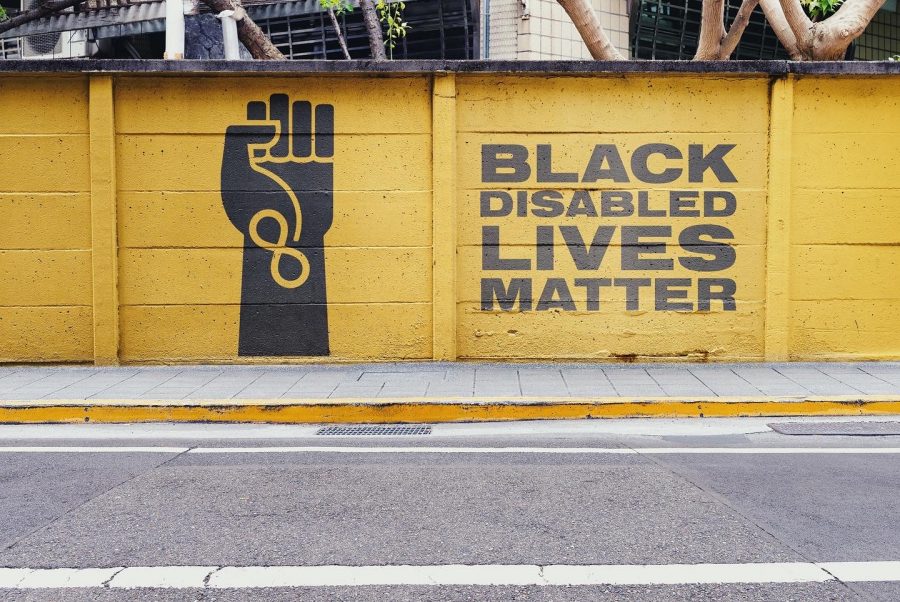
White-Johnson, J. Black Disabled Lives Matter Symbol.
[ID: A black fist is painted on a yellow wall with an infinity sign from the thumb joint down to the wrist. To the right of the fist, there is black text that reads “Black Diabled Lives Matter” in all caps and bolded letters.]
Michaela Oteri
Michaela Oteri is a digital artist, who uses her art to shed light on ableism. “My message [in my art] is that disabled people are people,” Oteri said.
Art has not always been a significant part of Oteri’s life. “Previously I didn’t have all that much interest, but I started getting sick, and it was an easy outlet to be able to explore and tell stories with my friends,” Oteri said.
Many people do not take ableism seriously and Oteri wants to make sure that she, along with her artwork, is able to demonstrate its harm. “[Ableism is] very impactful and it sometimes results in people dying,” Oteri said. “It’s very serious and so that’s something that’s a very important thing that I’ve had to come to terms with and learn about.”
Even though disabled people are the largest minority in the world, they do not receive a lot of respect, and Oteri wants to help gain that respect through her work. “There are disabled people in every part of the world, in every group, in every community,” Oteri said. “We just don’t get a lot of respect.”
“Disabled Beauty Series” by Michaela Oteri
Oteri’s “Disabled Beauty Series” is inspired by the Cripple Punk Movement, a social movement, started by Tyler Trewella, regarding the representation of disabled people in our society. “That entire movement is about accepting yourself despite the ableism,” Oteri said. “That’s what I went forward with for my portrait series.”
Oteri initially wanted to create this series to educate others about disabled people, but the process of creating these portraits has sparked a new awareness in herself as well. “I’ve really learned a lot about myself, my perception of disability and my understanding of disability,” Oteri said.
Oteri’s favorite part about creating these portraits is observing her subjects’ reactions to the final product. “It’s so great to have the feeling of people just approaching me online and [saying], ‘Wow, I just saw myself in art for the first time, I’ve never seen myself this way before,’” Oteri said. “Not even a portrait of themselves, just a portrait of a person that looks like them.” One of the reasons Oteri decided to pursue art was to communicate her thoughts on disability culture to the rest of the world. “We’re beautiful individuals,” Oteri said. “And we deserve to be seen that way.”

Oteri, M. (2020). Memorial Portrait of Ki’Tay Davidson.
According to Oteri’s website, “Ki’tay was the co-creator of the hashtag #DisabilitySolidarity and was a champion for disability and LGBT rights. He passed away in 2014.”
[ID: A digital portrait of a young black man. He is wearing a suit with a patterned pink shirt and lavender tie as well as a pin that says “Love Wins”. He is holding a microphone and appears to be speaking to the viewer. The background is art nouveau inspired and decorated with forget me not flowers.]
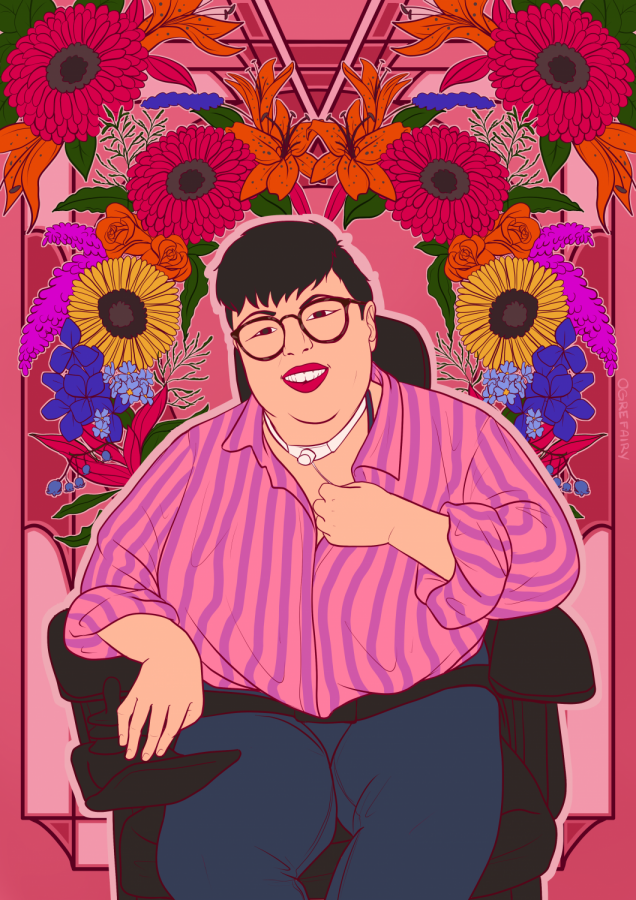
Oteri, M. (2020). Memorial Portrait of Stacey Park Milbern.
According to Oteri’s website, “Stacey Park Milbern passed away in May of 2020, on her 33rd birthday. She was loved by many and respected by even more. She was an amazing advocate for disabled people, especially BIPOC and will be dearly missed.”
[ID: A digital portrait depicting a mixed-race Asian American woman. She is sitting in a power wheelchair and has a trach. She is wearing a striped pink and purple shirt, glasses, jeans, and has short dark hair. Behind her is a ring of very large and vibrant flowers of different types, matching more in the upper corners.]
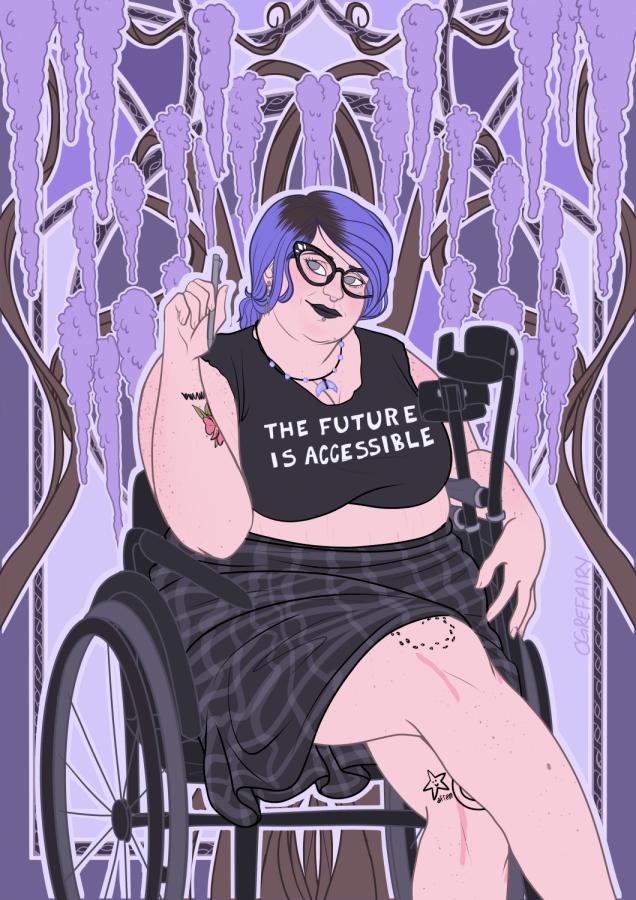
Oteri, M. (2020). Self Portrait.
[ID: A digital portrait depicting a fat white woman with blue/purple-dyed hair pulled back into a ponytail. She is wearing a crop top that reads “The Future Is Accessible” and a black plaid skirt. She is holding up a pen in her right hand while sitting in a wheelchair and holding a pair of forearm crutches. The background is a blue/purple and art nouveau inspired with vining purple wisteria flowers.]

Oteri, M. (2017) Memorial Portrait of Tyler Trewhella the person who started the #CripplePunk Movement.
According to Oteri’s website, “Tyler (or Tai) passed away in Novemeber of 2017. They were the person who popularized Cripple Punk as a movement and changed the lives of many people.”
[ID: An art nouveau inspired digital artwork depicting Tyler, a white pale and lean nonbinary person with short dark hair, a cigarette resting in their mouth, and a black cane covered in stickers. They are wearing a spiked choker, a burgundy over-shirt, over a black shirt, and black jeans. Behind them is a wreath of yellow roses.]
Photo captions courtesy of Michaela Oteri.
Featured Image courtesy of Jennifer-White Johnson.
Print Issue
Please click on the three vertical dots on the top right-hand corner, then select “Two page view.”

2020-2021 - Staff Writer
2021-2022 - Online-Editor-In-Chief
I joined C Magazine because I love journalism and design. My favorite part about this...
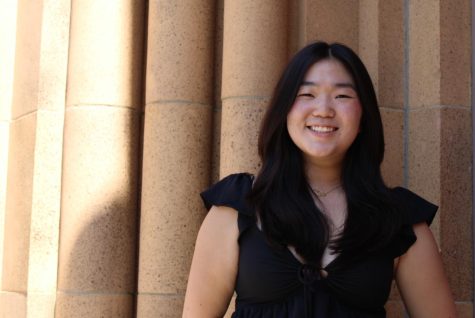
2021-2022 - Staff Writer
2022-2023 - Business Manager
I joined C mag because art has always been a big part of my life. I always loved looking through...

2021-2022 - Staff Writer
2022-2023 - Editor-In-Chief
I joined C mag because I saw it as a really cool way to learn more about the Paly community,...



